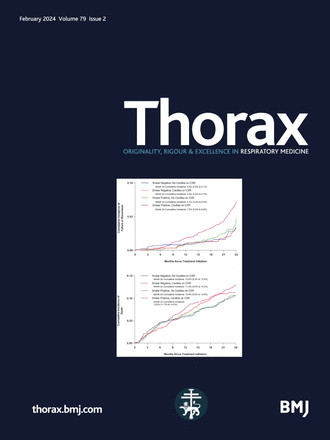Association of time spent on social media with youth cigarette smoking and e-cigarette use in the UK: a national longitudinal study
IF 7.7
1区 医学
Q1 RESPIRATORY SYSTEM
引用次数: 0
Abstract
Background Social media may influence children and young people’s health behaviour, including cigarette and e-cigarette use. Methods We analysed data from participants aged 10–25 years in the UK Household Longitudinal Study 2015–2021. The amount of social media use reported on a normal weekday was related to current cigarette smoking and e-cigarette use. Generalised estimating equation (GEE) logistic regression models investigated associations of social media use with cigarette smoking and e-cigarette use. Models controlled for possible confounders including age, sex, country of UK, ethnicity, household income and use of cigarette/e-cigarettes by others within the home. Results Among 10 808 participants with 27 962 observations, current cigarette smoking was reported by 8.6% of participants for at least one time point, and current e-cigarette use by 2.5% of participants. In adjusted GEE models, more frequent use of social media was associated with greater odds of current cigarette smoking. This was particularly apparent at higher levels of use (eg, adjusted odds ratio (AOR) 3.60, 95% CI 2.61 to 4.96 for ≥7 hours/day vs none). Associations were similar for e-cigarettes (AOR 2.73, 95% CI 1.40 to 5.29 for ≥7 hours/day social media use vs none). There was evidence of dose–response in associations between time spent on social media and both cigarette and e-cigarette use (both p<0.001). Analyses stratified by sex and household income found similar associations for cigarettes; however, for e-cigarettes associations were concentrated among males and those from higher household income groups. Conclusions Social media use is associated with increased risk of cigarette smoking and e-cigarette use. There is a need for greater research on this issue as well as potential policy responses. Data are available in a public, open access repository. Data available from UK Data Service英国青少年在社交媒体上花费的时间与吸烟和使用电子烟的关系:一项全国纵向研究
背景 社交媒体可能会影响儿童和青少年的健康行为,包括香烟和电子烟的使用。方法 我们分析了英国 2015-2021 年家庭纵向研究中 10-25 岁参与者的数据。平日社交媒体使用量与当前吸烟和使用电子烟的情况有关。广义估计方程(GEE)逻辑回归模型调查了社交媒体使用与吸烟和使用电子烟之间的关系。模型控制了可能的混杂因素,包括年龄、性别、英国国家、种族、家庭收入和家庭中其他人使用香烟/电子烟的情况。结果 在 10 808 名参与者的 27 962 次观察中,有 8.6% 的参与者至少在一个时间点上报告了当前吸烟的情况,有 2.5% 的参与者报告了当前使用电子烟的情况。在调整后的 GEE 模型中,更频繁地使用社交媒体与更高的当前吸烟几率相关。这一点在使用频率较高时尤为明显(例如,调整后的几率比(AOR)为 3.60,95% CI 为 2.61 至 4.96,使用时间≥7 小时/天 vs 无)。电子烟的相关性与此类似(社交媒体使用时间≥7小时/天与无社交媒体使用时间≥7小时/天的相关性为2.73,95% CI为1.40至5.29)。有证据表明,社交媒体使用时间与香烟和电子烟使用之间存在剂量反应关系(两者的 p. 均为 0.05)。
本文章由计算机程序翻译,如有差异,请以英文原文为准。
求助全文
约1分钟内获得全文
求助全文
来源期刊

Thorax
医学-呼吸系统
CiteScore
16.10
自引率
2.00%
发文量
197
审稿时长
1 months
期刊介绍:
Thorax stands as one of the premier respiratory medicine journals globally, featuring clinical and experimental research articles spanning respiratory medicine, pediatrics, immunology, pharmacology, pathology, and surgery. The journal's mission is to publish noteworthy advancements in scientific understanding that are poised to influence clinical practice significantly. This encompasses articles delving into basic and translational mechanisms applicable to clinical material, covering areas such as cell and molecular biology, genetics, epidemiology, and immunology.
 求助内容:
求助内容: 应助结果提醒方式:
应助结果提醒方式:


